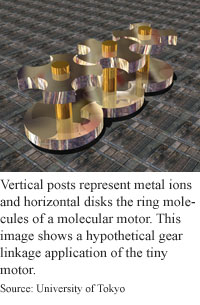
Molecular motor shifts speeds
By Eric Smalley, Technology Research NewsIn the drive to harness molecular forces to power microscopic devices, researchers at the University of Tokyo have made a rotary motor with a built-in transmission system.
The motor consists of two ring-shaped molecules sandwiching a metal ion. The ion acts as a bearing and the rings naturally rotate around it in opposite directions. The rate of rotation depends on the number of electrons in the rings.
The researchers have also combined several of these double-decker motors into columns. "We have synthesized a sort of columnar stack of double-decker complexes where the rotation of each double-decker is preserved," said Takuzo Aida, a chemistry professor at the University of Tokyo.
The motors could eventually power nanoscale mechanical devices and serve as electromechanical switches for future computer memory and logic units, if they can be controlled individually and added to larger systems.
The motor changes speeds via a reduction-oxidation (redox) reaction. When the rings gain an electron by oxidation they move closer together, which slows the rotation. The rings can undergo two levels of oxidation, making a three-speed motor.
In the single oxidation state the rate of rotation is 21 times slower than the neutral state, and in the double oxidation state the rate is nearly 100 times slower. The specific rates of rotation vary according to the acidity of the solution but are generally many thousands of times per second, Aida said.
The double-decker motor is compelling, said Joseph Lyding, a professor of electrical and computer engineering at the University of Illinois. "[We're] beginning to see strong indications and clear proof that you can control molecular motion. If you combine that with the ability to position a molecule on a surface with atomic precision, then you can start thinking about assembling more complex structures in which you take advantage of that molecular motion."
The researchers are exploring ways to attach the double-decker motors to other structures or surfaces. They have combined the motors with other molecules but the results are preliminary, Aida said, and he declined to provide details.
The motors work in solution. It's not clear whether the rotational behavior would be preserved if the motor was attached to a surface, he added.
However the motors are harnessed, an important step toward using them will be halting one of the rings while keeping the other rotating. In theory, the natural molecular forces alone won't support unidirectional rotation, said Aida. However, periodic energy injections like pulses of light have the potential to do this, he said.
Researchers should be able to use the motors in primitive molecular machines within a couple of years, said Aida. However, practical applications are probably decades away, he said.
Aida's colleagues were Kentaro Tashiro and Katsuaki Konishi. They published their work in the August 3, 2000 issue of the Journal of the American Chemical Society. The research was funded by the Japan Society for the Promotion of Science, the Izumi Science and Technology Foundation, the Yazaki Memorial Foundation for Science and Technology, and the Ministry of Education.
Timeline: <2 years; >10 years
Funding: Private; Government
TRN Categories: Biological, Chemical, DNA and Molecular Computing; Nanotechnology
Story Type: News
Related Elements: Image; Technical paper, "Metal Bisporphyrinate Double- Decker Complexes as Redox-Responsive Rotating Modules," Journal of the American Chemical Society, August 3, 2000
Advertisements:
November 29, 2000
Page One
Molecular motor shifts speeds
Virtual mic carries concert hall sound over 'net
Researchers ready radio-receiver-on-a-chip
Proton memory is ultracheap but slow
Crystal forms gas-triggered switch

News:
Research News Roundup
Research Watch blog
Features:
View from the High Ground Q&A
How It Works
RSS Feeds:
News
Ad links:
Buy an ad link
| Advertisements:
|
 |
Ad links: Clear History
Buy an ad link
|
TRN
Newswire and Headline Feeds for Web sites
|
© Copyright Technology Research News, LLC 2000-2006. All rights reserved.